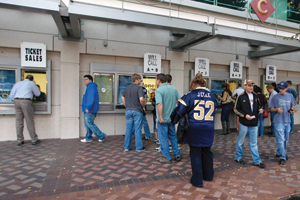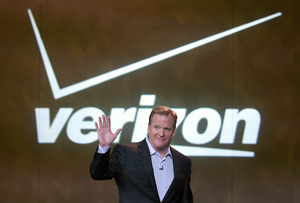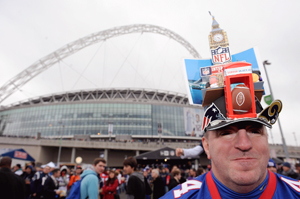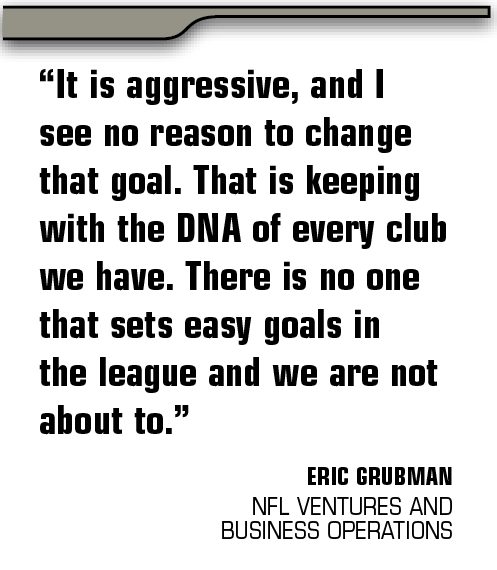Thirty-five months ago, NFL Commissioner Roger Goodell set a heady goal for team owners: triple the league’s then nearly $8.5 billion of revenue during the next 18 years. It was an aggressive pitch, requiring $917 million of new revenue annually.
Now, three years later, despite the league’s success and record-breaking popularity, the NFL is off the pace necessary to reach the target, with about $1 billion of revenue added since then.
The league stands by the $25-billion-by-2027 goal, though with $9.5 billion of revenue in 2012, sources said, the NFL now must average more than $1 billion annually of new revenue over the next 15 years.
“The financial landscape has been a pretty tough one, it has affected most companies in America. The [2011] CBA [process] set us back,” said Eric Grubman, executive vice president of NFL ventures and business operations. “I think
we are doing OK … our fans are still having a tough time [financially].”
The revenue target, introduced during the 2010 annual owners meeting in Orlando, did not come from projecting existing NFL business out to 2027. Instead, Grubman explained, the league intended the figure to convey what scale the NFL needed in order to compete as a global entertainment brand. And compete not just against other sports leagues, such as the English Premier League, but consumer product companies such as Procter & Gamble, Walt Disney and Apple.
“It is aggressive,” Grubman admitted of the $25 billion aspiration, “and I see no reason to change that goal. That is keeping with the DNA of every club we have. There is no one that sets easy goals in the league and we are not about to.”
Clearly, relying on the old bread-and-butter-sports economics of selling tickets, concessions and parking barely moves the needle in a quasi-recessionary environment. Instead, if the NFL is to enjoy 163 percent growth in the next 15 years, it must get even more money out of media, and create new lines of businesses.
“Traditional areas are very tough to grow,” said Jim Steeg, a former NFL and San Diego Chargers executive. “The vast majority of teams over the last five or seven years have remained fairly flat on that multiple.”
 |
Traditional revenue streams such as ticketing have largely flattened out, so the league will have to look elsewhere for significant growth.
Photo by: AP Images |
The NFL is trying to endow game tickets with more value, adding experiences to the price of premium seats, for example. And the league has succeeded in stemming a growing tide of non-sellouts. But no one is fooling anyone into believing that selling tickets and food gets the NFL very far toward $25 billion.
Mining growth in media
One clear engine for revenue growth is the same as for so many of the past increases: media. The NFL already has some built-in advantages. The new TV contracts in 2014 will generate significantly higher rights fees, while the 2011 CBA not only helped owners keep player costs in check, but secured labor peace through 2021, thereby easing any game-interruption concerns for new and existing partners. New NFL Network distribution deals cut late last year with Cablevision and Time Warner Cable already add to the pie.
But factoring in a few billion dollars more annually from the new TV deals and NFL Network subscription fees, the NFL is still only at the halfway point, or a little more, toward its revenue goal.
The league’s deals with Fox, NBC, CBS and ESPN expire in 2021 or 2022, so the next round of renegotiations should contribute toward the 2027 goal. Unless a major event occurs, like player health and safety dulling the popularity of the game, or an economic or military catastrophe, the NFL seems assured of reaping more in rights fees from traditional outlets on broadcast and cable TV. And the league could always bid out the NFL Network’s package of 13 games, though to do so it would have to weigh what it loses in subscription fees and ad sales, against what might be gained in rights fees. A 13-game Thursday and Saturday package is not sacrosanct, Grubman commented; it could always get bid out to another channel.
The league will need more than that, however, to arrive at the scale Goodell identified as necessary to compete globally against other major entertainment companies.
Clearly in the NFL’s favor is its position as the top-rated entertainment program in a fragmenting media universe. Programmers pay top dollar for shows that capture viewers and are immune from channel surfing and recording devices that skip through ads. Perhaps more than any property on TV, the NFL matches these criteria.
The question then is, seeing as the league likely only gets one more bite at a new broadcast and cable package before 2027, can the NFL begin to capitalize and collect fees for showing its games outside the current platforms?
 |
Commissioner Roger Goodell waves during a Verizon-sponsored event at this year’s International Consumer Electronics Show in Las Vegas. The league’s deal with Verizon expires in 2014, opening the possibility that the NFL could test the mobile market for selling games.
Photo by: Getty Images |
“Some form of subscription will be out there,” said Tom Spock, a former NFL executive, and co-founder of media consultancy Scalar Media Partners. “This may or may not be the last exclusive for DirecTV.”
DirecTV’s out-of-market package, for which it pays $1 billion annually, expires after 2014. The league could proceed in several directions at that juncture: sell the package to cable companies, a la the other leagues; keep it intact as an exclusive; or even allow some form of selling games directly to fans if the network partners allow it.
Figuring out the future of the DirecTV model underscores that the NFL’s biggest revenue opportunity is cashing in on its tremendous TV popularity, but on a much greater level and through different mediums than today.
“We are cracking the code on how to distribute,” Grubman said. Tablets, laptops, smartphones, each could offer subscriptions services.
Grubman used the phrase “NFL Everywhere” to talk about the possibilities, a turn of the phrase “TV Everywhere,” used by cable companies to describe viewing programming on different devices.
In the past, the broadcasters have largely blocked efforts by the NFL to show games outside traditional mediums. The NFL has proved, Grubman argued, that providing content on different devices doesn’t cannibalize network ratings.
NBC’s Sunday night games are streamed on NBCSports.com, for example, and those games are often the highest-rated TV show of the week.
In 2014, the NFL’s deal with Verizon expires, at which point the league can test the mobile market for selling games more widely in that space.
The move to widely sell games and packages on different devices, if it arrives, could also lead to another treasure trove: pressure on Nielsen Media to move away from household TV rating measurements.
“A big potential in revenue will come from a new method and better counting of viewers,” Grubman said. “Our broadcast and cable partners are selling ads based on viewers being counted at home. It undercounts.”
If ESPN and the networks can charge more for ads, then they can afford to pay the NFL even more.
International a question mark
One space that has yet to provide significant revenue is international markets (in fact, during the now defunct NFL Europe days the sector dragged on the league’s bottom line). The league five years ago began playing regular-season games in London, and the city hosts two regular-season games for the first time during the 2013 season.
Longtime observers, however, worry that the league is simply continuing its lengthy, futile efforts outside of America. There are no reliable external estimates for NFL revenue overseas, though the league often talks up growth rates in rights fees.
“I scratch my head why the NFL has struggled so much internationally,” said Frank Vuono, who oversaw the NFL’s
 |
The league has attracted enthusiastic crowds to games in London, but is still seeking ways to significantly build its international business.
Photo by: Getty Images |
merchandise business in the 1990s and now runs the consulting firm 16W Marketing.
And Scalar’s Spock added, “there have been 35 years of really trying hard to make an impact and it is very slow going. There may be some upside there, but it’s not likely to be a major contributing factor.”
The league will try, and not just in London with live games, but selling TV rights in Asia and trying to establish itself on the world stage.
“Roger [Goodell] has a very big mission, and the NFL has a big plan for global expansion,” said David Moross, chairman of private equity firm Falconhead, which has done business with the NFL. “Distribution outside this country is an opportunity.”
There are other obvious areas for revenue growth. Among them:
■ Expanding the regular season and the playoffs, which Goodell has so far championed to little success. The players oppose adding games to the regular season, and adding playoff teams has not been well-received in many circles.
Grubman insists these are not revenue ideas, and points to the fact that the league even considered shrinking the season by two preseason games, and keeping the regular season at 16, as evidence. Goodell, Grubman added, is motivated not by revenue when it comes to season structure, but to shrink the unappealing preseason.
■ A team moving to Los Angeles would create revenue by opening the second-largest market in the country to a team, and presumably subtracting the low revenue market a club relocated from.
There are others with more exotic ideas on how to grow.
■ The NFL would profit immensely if it embraced sports gambling, Vuono contended, like the English Premier League. That seems highly unlikely in the conservative NFL, which has vociferously opposed expansion of sports gambling outside Las Vegas.
■ Arlen Kantarian, a former NFL executive and top tennis official, said the NFL should create its own apparel and ticketing company, rather than just collect royalties. “They are powerful enough to consider that down the road,” said Kantarian, who operates through his boutique Kantarian Sports Group.
■ The NFL could buy another sports league like Major League Soccer, he opined, to run during its offseason.
“They have a lot of legs left,” Kantarian said. “They are probably in the early third quarter of their opportunity to generate revenue.”







